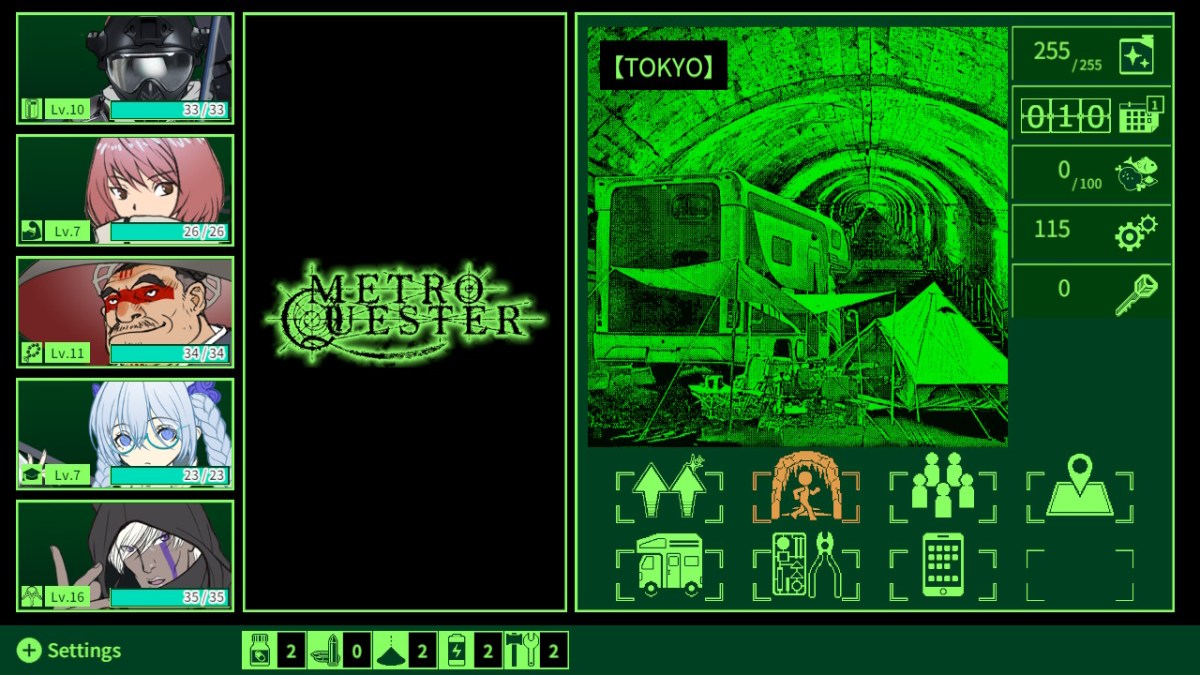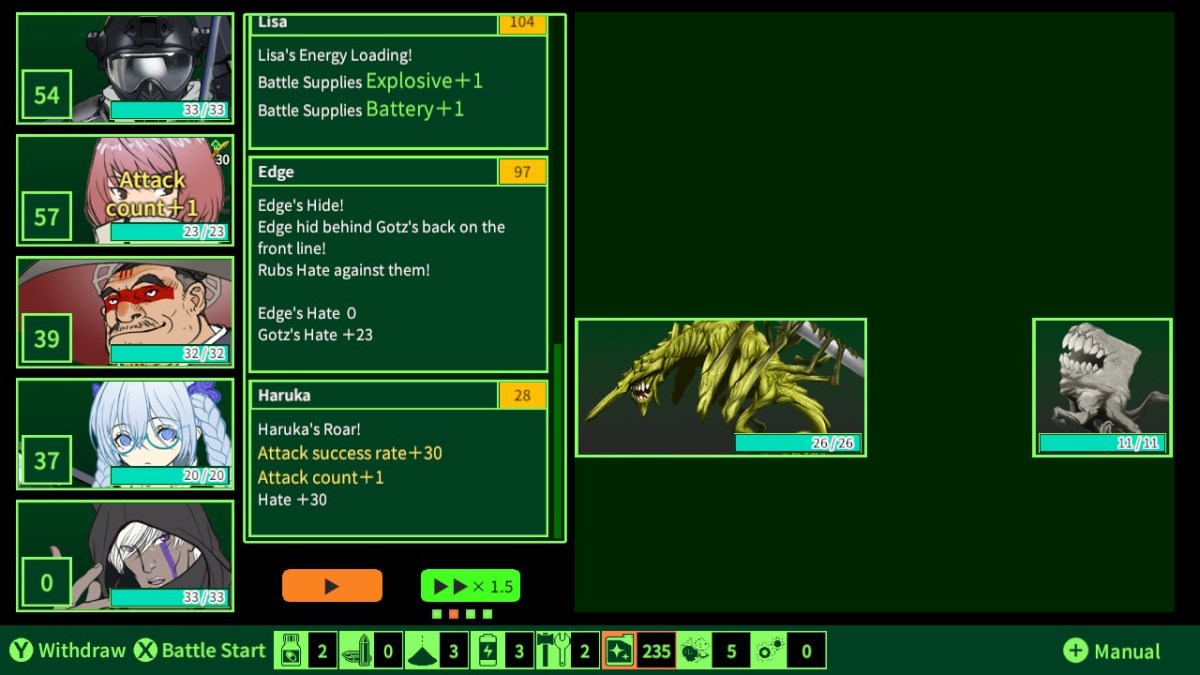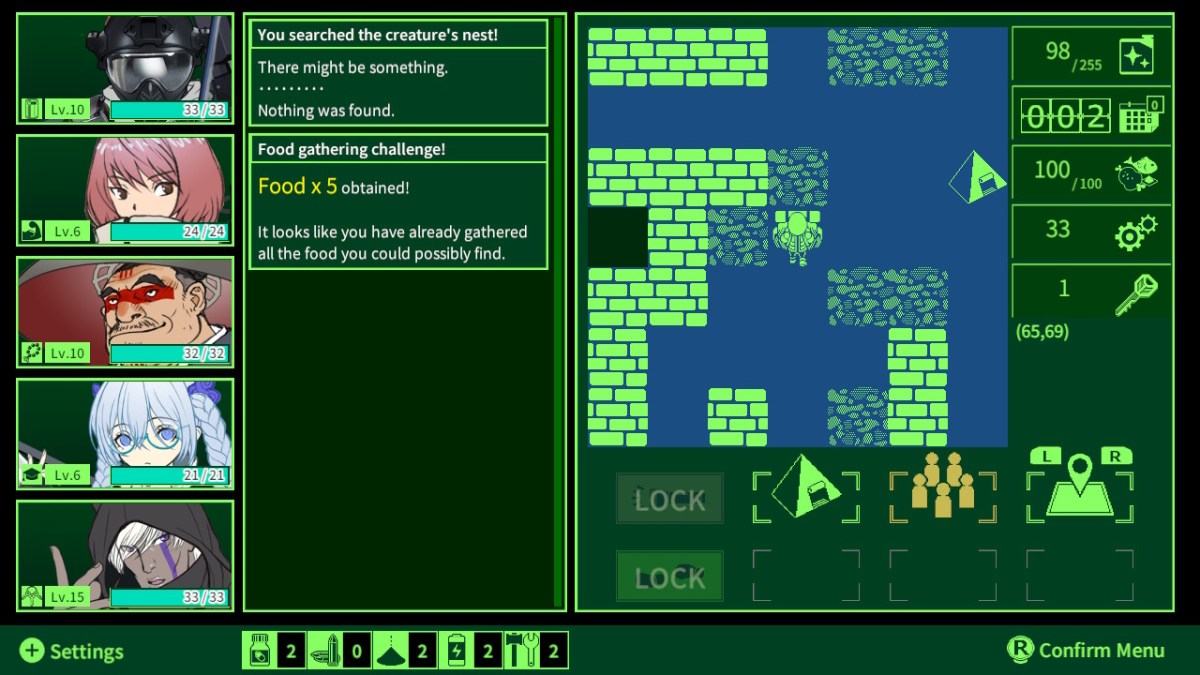KEMCO RPGs can get a bad rap sometimes, due to things like how often they come up, how some look like they’re made with RPG Maker software, and a few being titles that rely heavily on JRPG tropes. Metro Quester, a KEMCO title developed by Thousand Games, is something rather unique, and it’s one of the most special games from the company I’ve played.
Going into Metro Quester, it’s important to note that it isn’t a typical “save the world” JRPG. It isn’t bright and colorful, filled with NPCs and towns. It’s a far more streamlined and driven experience. The world basically ended, with people heading into the ruins of Tokyo to search for food and resources as long as the Purification Fuel will allow them to explore down in this new “dungeon” with the monsters. You’ll go in knowing you need to get 100 fuel each week to keep going, checking established food cites and moving to discovered campsites in places like Otemachi and Ginza, and surviving monster encounters until you’re forced to return to camp, regroup, and try again.

To help enforce the fact that circumstances are dire, the only color comes from the characters themselves. Each one is based on art from Bastard creator Kazushi Hagiwara. Their equipment and role determines their skills. The action points for each action determine which can be used in battle, since you can only set up to five points worth of actions and each ability can only be used once. You can only level up when at an established camp after having earned enough experience during a run and if you have enough resources.
The Action Points and battle system is fascinating. So say my Mobile Police Gotz could use the Stronghold ability for two points to raise everyone’s defense by one, his Kicking Mitt shield has a one point Iron Wall action to raise his defense by two, and I could have him use Vanguard for one AP to draw enemies’ Hate and be more likely targeted that round. That accounts for all his actions one turn. You set all actions before any turn begins, which means you could essentially set an auto-battle for an entire fight. Once everyone’s up-to-three actions are locked in, you start the round and watch as it all plays out without further input. Since some people, like the Professor with bombs that require energy loading, batteries, and explosives, and the Buddhist that needs medicines for the three-action-point healing prayer, require adjusted actions each turn, it does become about strategy and choosing when to act.
Every adventure starts in Tokyo, with the mandate that you need to get 100 food within seven days to keep going. You then explore a completely uncharted dungeon, with areas revealing themselves as you walk up to them. Some are dirt-covered patches, which you can dig through. You may find ruins with food or monster nests with food, items, or additional monsters. Keys can come up as you explore, allowing you to open doors to new parts of ruins. Happening upon campgrounds allows you to sacrifice some food to move your base camp hub, so you can start from that spot next time to reach new areas. Fighting monsters drops food, and getting to new locations may mean extra resources.
It means that every time you head into Metro Quester, you’re making the sorts of decisions you might not normally encounter in KEMCO RPGs or JRPGs. Do you go to established spots where you found food before or chart new areas? That enemy icon is red, showing it’s a stronger and more dangerous one than a blue one. Do you approach it? Do you go to a different camp or stay where you are? If you happened to find new weapons, do you equip them or use them to modify some other piece of equipment you’re using because you appreciate its skills? I constantly asked myself exactly how comfortable I was pushing my limits each time.

Also, there’s a satisfying challenge in Metro Quester that isn’t present in some of the other KEMCO RPGs I’ve played. It gives me the same sense of satisfaction as Dungeon Encountersand Etrian Odyssey Origins Collection, two other “demanding” Switch games I love. Especially since the game auto-saves. You can’t undo your decisions. You have to live with your choices and hope you made the right ones that won’t result in you eventually failing because you weren’t properly managing your resources, equipment, and time.
If someone does like other KEMCO RPGs and JRPGs that are more story-focused though, Metro Quester probably won’t be a good fit. You aren’t getting to really know your party of characters and dealing with established individuals as you go through a rich story. This is about survival. It’s about making your party and characters your own as you determine which equipment makes them most effective, who will be the most useful on your runs, and decide which people need to be with you or left behind.

If someone were to ask me which KEMCO games to play, Metro Quester would not just be on that list. It would absolutely be somewhere near the top of it. While the nature of it means it isn’t going to be for everyone who typically goes for every KEMCO RPG, it’s a really special and challenging experience that makes you think about all your actions.
Metro Quester is available on the Nintendo Switch, PS4, PS5, Xbox One, and Xbox Series X. Quester is available on the PC via Steam.
Metro Quester is a dungeon exploration RPG based in a post-apocalyptic futuristic world created by the manga artist Kazushi Hagiwara, with a deep game system designed by Hironori Kato that offers the excitement and surprises reminiscent of 1980s computer games through hack and slash. Switch version reviewed. Review copy provided by company for testing purposes.
Metro Quester is one of the most unique KEMCO RPGs I’ve played, and it really challenges people to put together a party and survive.
- The soundtrack is fantastic and quite retro, and you can turn an optional CRT scanline effect on.
- If a character falls in a fight, they revive after battle, which helps with exploring and survivability. If everyone dies, you all revive at camp after losing half of your food, resources, and some experience.
- I recommend bringing the Mobile Police, Buddhist, Detonator, Ranger, and Stealer along. They all were really helpful when I played.


Published: Jan 12, 2024 03:00 pm